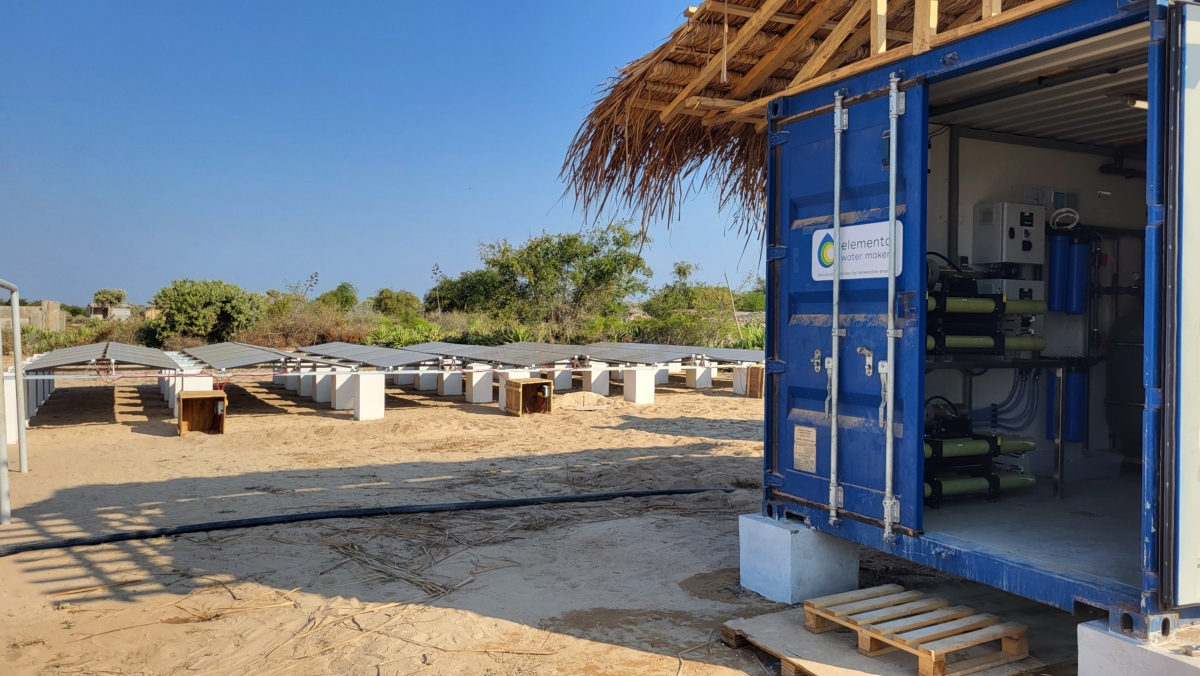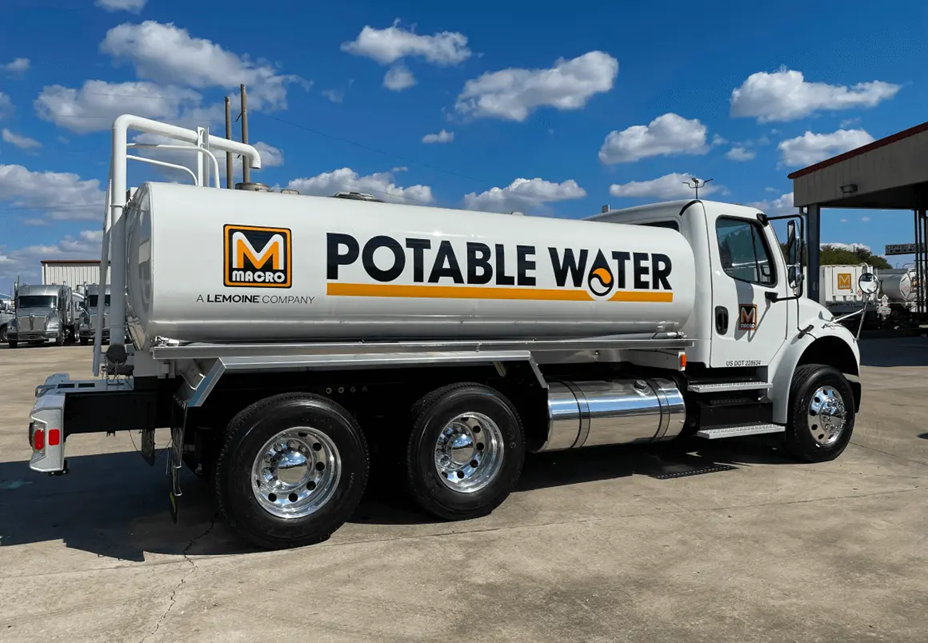Solar desalination is a sustainable water treatment technology that harnesses solar energy to convert seawater into freshwater through reverse osmosis or similar processes. This innovative approach combines photovoltaic panels with desalination equipment, eliminating dependence on traditional power grids whilst reducing operational costs significantly. For coastal properties facing water scarcity and high procurement costs, solar desalination offers a reliable, environmentally friendly solution that produces clean water that meets WHO drinking water standards.

Solar desalination solution in Madagascar
What is solar desalination and how does it work? #
Solar desalination represents a breakthrough in sustainable water production, combining renewable solar energy with advanced desalination technology to transform seawater into freshwater. At its core, this process uses photovoltaic panels to generate electricity that powers reverse osmosis systems, which push seawater through semi-permeable membranes to remove salt and other minerals.
The technology works by capturing solar energy during daylight hours, converting it to electricity that drives high-pressure pumps. These pumps force seawater through specialised membranes with microscopic pores that allow water molecules to pass whilst blocking salt and contaminants. Modern systems incorporate energy recovery devices that capture and reuse pressure from the brine discharge, dramatically improving efficiency.
What makes solar desalination particularly attractive for coastal properties is its independence from unreliable power grids. Our solutions only use 3 kWh/m³ compared to traditional desalination solutions that use 7-10 kWh/m³ of fresh water produced. The modular, containerized designs mean systems can be operational within hours of arrival at a location, making them ideal for remote coastal areas where traditional infrastructure is limited or non-existent.
Why is solar desalination important for coastal properties? #
Coastal properties, particularly resorts and private estates in island nations, face unique water challenges that solar desalination directly addresses. Current spending of water users, including resorts, villas and industries on islands and water-scarce coastal regions can range between 5-10 €/m³, creating unsustainable operational expenses that significantly impact profitability. For luxury resorts where guest satisfaction depends on reliable water supply, these costs represent a major operational burden.
Beyond economics, many coastal regions struggle with unreliable municipal water infrastructure. Frequent service interruptions, inadequate pressure systems, and seasonal shortages force properties to maintain expensive backup solutions. For commercial users or communities in remote regions, having to truck or transport water can be much more expensive, ranging from 10-20 €/m³, which are not only costly but also vulnerable to weather disruptions and logistical challenges.
Solar desalination offers environmental benefits that align with modern sustainability commitments. Unlike traditional water treatment methods requiring chemical dosing, solar-powered systems operate chemical-free, eliminating safety risks for staff and guests whilst protecting delicate coastal ecosystems. This approach helps properties meet increasingly stringent environmental regulations and appeals to environmentally conscious guests who expect sustainable practices from luxury destinations.
What are the main components of a solar desalination system? #
A complete solar desalination system integrates several key components working together to produce clean freshwater efficiently. The foundation consists of solar panels that generate electricity, typically arranged in arrays sized to match the system’s daily production capacity. These panels connect to inverters that convert DC power to AC for operating the desalination equipment.
The heart of the system includes:
- Energy recovery devices that capture pressure from brine discharge, reducing energy consumption by recycling hydraulic energy
- Reverse osmosis membranes, typically 2.5 inch by 21 inch or larger, that perform the actual salt removal
- Pre-treatment filters that remove suspended solids and protect the membranes from damage
- High-pressure pumps that create the necessary pressure for reverse osmosis
- Storage tanks for both raw seawater intake and finished freshwater
- Remote monitoring systems enabling operators to track performance and troubleshoot issues from anywhere
Modern systems feature modular, containerized designs that simplify transportation and installation. These plug-and-play units arrive pre-assembled and tested, requiring minimal site preparation. The containerized approach also protects sensitive equipment from harsh coastal conditions, ensuring reliable operation for over 10 years with proper maintenance.
How much freshwater can solar desalination produce daily? #
Solar desalination systems offer flexible production capacities ranging from 5,000 to 100,000 litres per day, making them suitable for everything from small private villas to large resort complexes. The actual output depends on several factors, with solar radiation levels being the primary determinant. Systems in Caribbean locations with abundant sunshine typically achieve higher daily production than those in regions with more variable weather.
System size and configuration also influence production capacity. A small villa might require only 5,000-10,000 litres daily for guest rooms and facilities, whilst a 200-room resort could need 50,000-100,000 litres to meet all operational requirements including pools, landscaping, and laundry services. The modular nature of solar desalination allows properties to start with smaller capacity and expand as needed.
Importantly, all produced water meets WHO drinking water standards, ensuring safety for direct consumption. The reverse osmosis process removes not only salt but also bacteria, viruses, and other contaminants, producing water quality that often exceeds municipal supplies. This reliability gives property managers confidence in serving the water to guests without additional treatment or concerns about quality variations.
What makes modern solar desalination different from traditional methods? #
Modern solar desalination systems represent a significant advancement over traditional desalination methods in several critical areas. Energy efficiency stands out as the most dramatic improvement, with our solutions using only 3 kWh/m³ compared to traditional desalination solutions that use 7-10 kWh/m³ of fresh water produced. This efficiency comes from combining solar power generation with advanced energy recovery technology adapted from large-scale industrial plants.
The elimination of chemical dosing marks another major difference. Traditional systems often require chlorine, anti-scalants, and other chemicals that create safety hazards and environmental concerns. Solar desalination systems operate completely chemical-free, using only physical filtration and membrane separation. This approach reduces operational complexity, eliminates chemical storage requirements, and removes potential liability risks.
Installation and maintenance present stark contrasts between old and new approaches:
- Traditional systems require extensive civil works, concrete foundations, and complex piping networks
- Modern solar desalination arrives in plug-and-play containers, operational within hours
- Conventional plants need constant on-site technical supervision
- Solar systems feature remote monitoring, reducing maintenance visits and enabling predictive service
- Traditional desalination suffers frequent breakdowns in coastal conditions
- Modern systems demonstrate proven reliability exceeding 10 years in harsh environments
How can Elemental Water Makers help with your solar desalination needs? #
As a pioneering TU Delft spin-off operating since 2012, we’ve installed over 100 solar desalination systems across 35 countries, bringing sustainable water solutions to coastal communities worldwide. Our expertise spans the Caribbean, Pacific islands, and Africa, where we’ve helped resorts and private properties overcome water challenges whilst reducing operational costs.
We offer two flagship solutions tailored to different needs. Our off-grid Elemental Water Source enables full energy independence by producing fresh water using only renewable energy in remote areas, whilst our Efficient Desalination system minimizes energy consumption while delivering reliable freshwater for sites with an existing power supply. Both solutions deliver the same benefits: chemical-free operation, remote monitoring capabilities, and proven long-term reliability.
Our track record includes installations at luxury resorts facing water costs in the 5-10 €/m³ range, private islands with no municipal water access, and coastal communities seeking sustainable alternatives to trucked water. Our solutions can enable clean water for 1-3 €/m³, which includes the investment and 15 years of operational costs. Whether you manage a boutique resort or oversee a large coastal development, we can design a solar desalination solution that transforms abundant seawater into a reliable freshwater supply.
Frequently Asked Questions #
What maintenance is required for a solar desalination system and how often?
Solar desalination systems require minimal maintenance compared to traditional systems. Regular tasks include cleaning solar panels monthly, replacing pre-filters every 3-6 months, and conducting membrane cleaning or replacement every 2-3 years depending on water quality. Most maintenance can be performed by on-site staff with basic training, while remote monitoring allows technicians to diagnose issues before they become critical, typically requiring professional service visits only 2-4 times annually.
How do I determine the right system size for my coastal property?
System sizing depends on your daily water consumption, which varies by property type and occupancy. Calculate your needs by considering guest rooms (200-300 litres per room), pools, irrigation, laundry, and kitchen operations. Add a 20-30% buffer for peak seasons and future growth. Most properties benefit from starting with a modular system that can expand as needed, with typical resort installations ranging from 20,000-50,000 litres daily capacity.
What happens during cloudy days or at night when there's no solar power?
Modern solar desalination systems incorporate battery storage or hybrid configurations to ensure continuous operation. During peak sunlight hours, systems produce excess water stored in tanks for nighttime use. For properties with grid access, the system can automatically switch to grid power during extended cloudy periods. Off-grid installations typically include battery banks providing 8-12 hours of operation, with most systems designed to produce daily requirements within 6-8 hours of good sunlight.
Can solar desalination handle varying water salinity levels and what about the brine discharge?
Solar desalination systems automatically adjust to handle salinity variations common in coastal areas, from brackish water (3,000 ppm) to full seawater (35,000 ppm). The concentrated brine discharge, typically 1.5-2 times seawater salinity, can be safely returned to the ocean through proper diffusion systems that prevent environmental impact. Many properties also explore brine utilisation for salt production or aquaculture, turning waste into additional revenue streams.
What permits and regulations apply to installing solar desalination at coastal properties?
Permit requirements vary by location but typically include environmental impact assessments, coastal development permits, and water discharge authorisations. Most Caribbean and Pacific nations have streamlined processes for sustainable water projects, often completed within 2-3 months. Elemental Water Makers can help in submitting the technical data that may be required to apply for the permits locally.
How quickly can I expect return on investment and what financing options exist?
With water costs of €5-10 per cubic meter at many coastal properties, solar desalination systems typically achieve payback within 2-4 years. Properties spending €50,000+ annually on trucked water often see even faster returns. Financing options include green loans from development banks, equipment leasing programmes, and water-as-a-service models where you pay only for water produced. Some regions offer sustainability grants covering 20-40% of project costs, further improving ROI.

